Search results for: 'Amulett 664 332'
-
 Roman marble figurine of Salus
Roman marble figurine of SalusMarble torso of Salus or Hygeia, the goddess of health, holding a serpent in her arms. From the collection of Dr. Bruno Kirschner, Israel. Exported from Israel with permit of the IAA.
Price: on request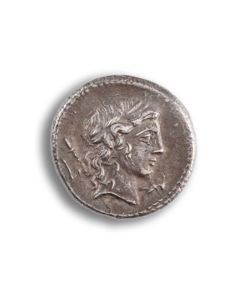 Vorzüglicher Denar des P. Crepusius mit herrlicher Patina
Vorzüglicher Denar des P. Crepusius mit herrlicher PatinaRevers: Nach rechts galoppierender Reiter mit erhobenem Speer. Außergewöhnlich erhaltenes Stück mit hohem, scharfem Relief.
Price: on request Egyptian faience ring showing Bes and Taweret
Egyptian faience ring showing Bes and TaweretThe finger ring with its scene on the plate must have served a protective function for an expectant mother. New Kingdom, approx. 1550 to 1070 BC.
Price: on request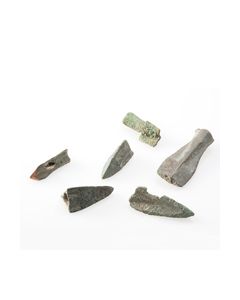 Gruppe skythischer Pfeilspitzen
Gruppe skythischer Pfeilspitzen6 antike Bronzepfeilspitzen. Meist dreiflüglig in guter Erhaltung. Typisch für skythische Völker ab ca. 700 v.Chr. Aus dem danubischen Raum.
Price: on request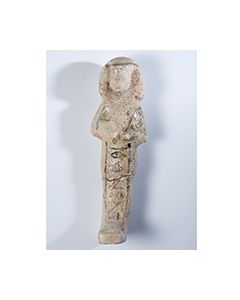 Musealer Ushebti mit Hieroglyphen
Musealer Ushebti mit Hieroglyphen22.-23. Dynastie, mit hieroglyphischer Inschrift. Typische Ausführung mit Stirnband und senkrechtem Hieroglyphenregister.Weiße Fayence, Höhe 10 cm.
Price: on request Near Eastern bronze sword
Near Eastern bronze swordDouble-edged blade of a Bronze Age sword, the hilt missing. From the middle of the 2nd Millennium BCE.
Price: on request Stirrup vessel with lizzards
Stirrup vessel with lizzardsBeautiful vessel from the golden age of the Moche culture. It shows two lizzards on each side. 100 to 500 AD.
Price: on request Luristan bronze spearhead
Luristan bronze spearheadDouble-edged blade of a large spear from the Luristan region in Ancient Iran. Impressive speciment with nice patina.
Price: on request Near Eastern lance head
Near Eastern lance headDouble-edged blade of a lance from Bronze Age. With a nice green patina.
Price: on request Luristan bronze dagger with grip insert
Luristan bronze dagger with grip insertBronze weapon originating from the Luristan region during Iron Age. Note the grip insert in this dagger otherwise comprised of a single piece of bronze.
Price: on request Four Scythian arrow heads
Four Scythian arrow headsGroup of four arrowheads made of bronze in excellent condition. Popular weapon of the cultures of the 1st Millennium BC.
Price: on request Bronze dagger with double-disc hilt
Bronze dagger with double-disc hiltElegant weapon of the Iron Age Amlash culture with broad and short blade. It is certainly a find from the province of Gilan in northern Iran.
Price: on request Near Eastern lance head
Near Eastern lance headDouble-edged blade of a lance from Bronze Age. Probably from Luristan in North Iran.
Price: on request Luristan point of a spear or arrow
Luristan point of a spear or arrowDouble-edged blade of a small spear or large arrow from the Early Iron Age of Iran.
Price: on request Mochica stirrup vessel as a shaman
Mochica stirrup vessel as a shamanImposing Peruvian vessel shaped like a priest on a podest with rich adornments. Circa 100 to 500 AD. With documents form the 1980ies.
Price: on request Luristan bronze dagger with tang
Luristan bronze dagger with tangDouble-edged blade of a short dagger from the Luristan region in Ancient Iran. An early type from the Middle Bronze Age.
Price: on request Two Near Eastern weapon points
Two Near Eastern weapon pointsGroup of two bronze points for small spears or large arrows from the Bronze or Early Iron Age. With a nice green patina.
Price: on request Late Roman Amphora with nice sea encrustation
Late Roman Amphora with nice sea encrustationWorth the exhibition in a museum. Completely intact, including the handles, one piece on bottom restored in antiquity. Found 1967 in the sea in Croatia, exported with permit of the local authorities.
Price: on request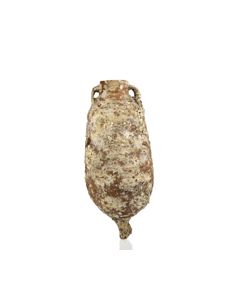 Late Roman Amphora with nice sea encrustation
Late Roman Amphora with nice sea encrustationVery good condition, incl. the well preserved pointed foot and loop handles. Found 1967 in the sea in Croatia, exported with permit of the local authorities.
Price: on request Large jug with nice sea encrustation
Large jug with nice sea encrustationPerfectly preserved. Found 1967 in the sea in Croatia, exported with permit of the local authorities.
Price: on request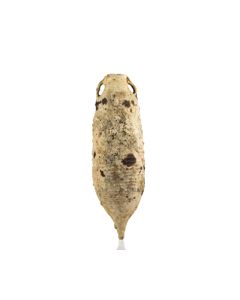 Tall Late Roman Amphora with nice sea encrustation
Tall Late Roman Amphora with nice sea encrustationVery good condition, incl. the well preserved pointed foot and loop handles. Found 1967 in the sea in Croatia, exported with permit of the local authorities.
Price: on request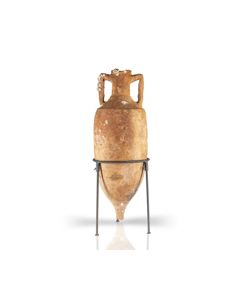 Roman wine amphora with nice sea encrustation
Roman wine amphora with nice sea encrustationVery impressive vessel in an excellent condition. Found 1967 in the sea in Croatia, exported with permit of the local authorities.
Price: on request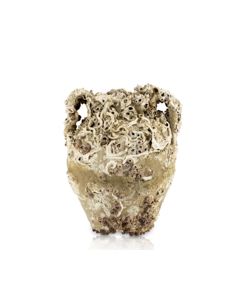 Small post-antique vase with strong sea encrustation
Small post-antique vase with strong sea encrustationNicely preserved. Found 1967 in the sea in Croatia, exported with permit of the local authorities.
Price: on request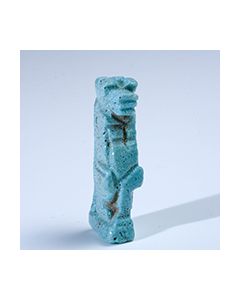 Ägyptisches Tauret-Amulett aus Fayence
Ägyptisches Tauret-Amulett aus FayenceAmulett der Nilpferdgestaltigen Göttin Tauret, der Göttin der Schwangeren und der Gebärenden. Intensive Farbgebung. Spätzeit, 26. - 30. Dynastie.
Price: on request Ägyptisches Papyrusamulett
Ägyptisches PapyrusamulettPapyrusamulett aus mintgrüner Fayence, symbolisch für Jugend und Gedeien. Spätzeit des Alten Ägyptens, 664 bis 332 v. Chr.
Price: on request Egyptian amulet of Taweret
Egyptian amulet of TaweretIt shows the goddess of childbirth in the form of a pregnant hippopotamus. The amulet from the Late Period of Ancient Egypt should exert a protective function. From a British private museum.
Price: on request Egyptian amulet of Taweret
Egyptian amulet of TaweretIt shows the goddess of childbirth in the form of a pregnant hippopotamus. The amulet from the Late Period of Ancient Egypt should exert a protective function. From a British private museum.
Price: on request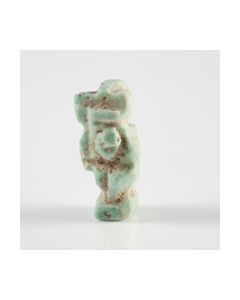 Ägyptisches Amulett der Taweret - Schutzgöttin der Schwangeren
Ägyptisches Amulett der Taweret - Schutzgöttin der SchwangerenMintgrüne Fayence. Spätzeit, Altes Ägypten, 26. bis 30. Dynastie. Hervorragender Zustand. Vollständig intakt.
Price: on request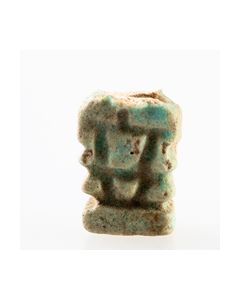 Ägyptisches Bes-Amulett
Ägyptisches Bes-Amulett26. bis 30. Dynastie, Altes Ägypten. Amulett in Form der ägyptischen Gottheit Bes in hockender Haltung, auf flachem Podest. Kopf und Haartracht fehlend.
Price: on request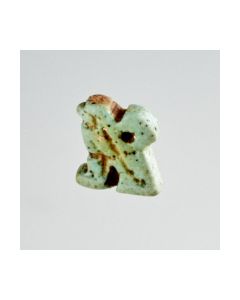 Egyptian amulet of a falcon
Egyptian amulet of a falconThe falcon in Egyptian art can be a depiction of the god Horus or symbolize the soul of the pharao. Falcon amulets are known from the earliest times in Egyptian history. However this speicmen dates to the Late Dynastic Period of Ancient Egypt.
Price: on request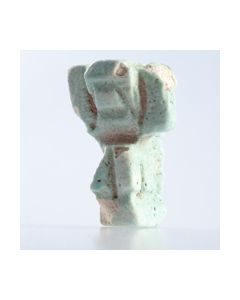 Ägyptisches Schu-Amulett
Ägyptisches Schu-AmulettAnhänger in Form der ägyptischen Gottheit Schu. Öse intakt, heute noch tragbar. Spätzeit des Alten Ägypten, ca. 652-332 v. Chr. 26. bis 30. Dynastie.
Price: on request Egyptian amulet of Anubis
Egyptian amulet of AnubisThe amulet from the Late Period of Ancient Egypt was supposed to protect the dead on their way to the afterlife. From a British private museum.
Price: on request Egyptian amulet of Anubis
Egyptian amulet of AnubisThe amulet from the Late Period of Ancient Egypt was supposed to protect the dead on their way to the afterlife. From a British private museum.
Price: on request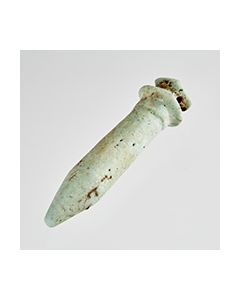 Egyptian papyrus scepter amulet
Egyptian papyrus scepter amuletPapyrus scepter made of faience. Late Period of Ancient Egypt. It symbolizes prosperity and youth. From the stock of a british private museum.
Price: on request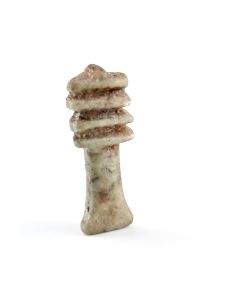 Djed-Pfeiler als Amulett
Djed-Pfeiler als AmulettÄgyptische Spätzeit, 26. bis 30. Dynastie. Mintgrüne Fayence. Der Djed-Pfeiler steht für Dauer und Beständigkeit und war im Alten Ägypten als Amulett sehr beliebt.
Price: on request Egyptian scarab amulet
Egyptian scarab amuletNice amulet from the Late Dynastic Period of Ancient Egypt. The scarab was exhibited in an early 20th century private museum.
Price: on request

